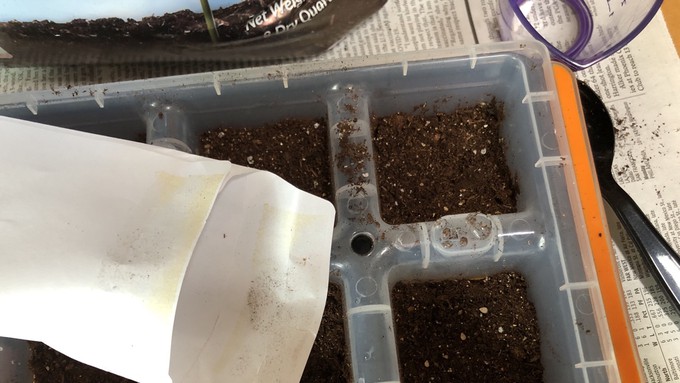
February ends on a wet and windy note

Since the weather's not conducive to being outdoors for long, it's a great time to get some (or more) tomato seeds started. Kathy Morrison
February is going out with a soggy roar.
Another wave of wintery weather is coming our way, pushed by strong winds.
According to the National Weather Service, expect some huge gusts on Monday – and maybe more fallen trees.
“Gusty winds will accompany the next storms tomorrow (through) Tuesday, but the strongest winds will be Monday,” the Sacramento NWS office tweeted Saturday. “Valley gusts up to 30-50 mph and mountain gusts up to 60-70 mph could cause downed trees and branches, localized power outages and difficult driving conditions.”
It won’t do much for gardeners, either – or our urban forest. Trees tend to lose their stability in soggy soil. Evergreens already wobbly after January’s storms could lose their roothold and topple over. Stay away from leaning trees or shrubs.
Besides the wind, more rain is in Sacramento’s forecast – which is a good thing. Downtown received almost an inch on Friday, bringing our total for February to 1.27 inches, but that’s still 2 inches below average. Normal for February: 3.59 inches.
After a drizzly Saturday, Sunday is expected to be wet with up to a half inch in Sacramento, says the weather service. Monday will see another half inch (or more) followed by additional showers on Tuesday.
Our yo-yo temperature pattern continues, too. The high on President’s Day Monday (Feb. 20) was 71 degrees, a record for that date; on Friday, it was 48. Sacramento also hit 71 on Feb. 12, with several days below normal in between those two peaks.
Our days this week will continue to be chilly – with highs mostly under 50 degrees. When the clouds finally clear midweek, the frost returns. The low in the wee hours of Thursday morning is expected to be 30 degrees with widespread frost.
All this cold and damp will put the brakes on our spring roll out. Protect tender transplants. Put off planting seed or setting out seedlings until soil warms.
* After this round of storms, feed spring-blooming shrubs and fall-planted perennials with slow-release fertilizer. Feed camellias after they bloom.
* Feed mature trees and shrubs after spring growth starts.
* Remove aphids from blooming bulbs with a strong spray of water or insecticidal soap.
* Fertilize strawberries and asparagus.
* Indoors, start peppers, tomatoes and eggplant from seed.
* It’s not too late to browse seed catalogs or websites and order for spring planting.
* Pot-up bareroot roses, berries, asparagus, rhubarb or other bareroot plants. The soil is too cold for good root development. Instead, soak bareroot plants overnight, then plant them in potting soil in black plastic pots lined with newsprint. In April or May, transplant them – rootball and all – into the garden.
Comments
0 comments have been posted.Sacramento Digs Gardening to your inbox.
Sites We Like
Garden Checklist for week of May 5
Survey your garden after the May 4 rainstorm. Heavy rain and gusty winds can break the neck of large flowers such as roses. Also:
* Keep an eye on new transplants or seedlings; they could take a pounding from the rain.
* Watch out for powdery mildew. Warmth following moist conditions can cause this fungal disease to “bloom,” too. If you see a leaf that looks like it’s dusted with powdered sugar, snip it off.
* After the storm, start setting out tomato transplants, but wait on the peppers and eggplants (they want warmer nights). Pinch off any flowers on new transplants to make them concentrate on establishing roots instead of setting premature fruit.
* Trim dead flowers but not leaves from spring-flowering bulbs such as daffodils and tulips. Those leaves gather energy to create next year's flowers. Also, give the bulbs a fertilizer boost after bloom.
* Pinch chrysanthemums back to 12 inches for fall flowers. Cut old stems to the ground.
* Mulch around plants to conserve moisture and control weeds.
* From seed, plant beans, beets, cantaloupes, carrots, corn, cucumbers, melons, pumpkins, radishes and squash.
* Plant onion sets.
* In the flower garden, plant seeds for asters, cosmos, celosia, marigolds, salvia, sunflowers and zinnias. Transplant petunias, zinnias, geraniums and other summer bloomers.
* Plant perennials and dahlia tubers for summer bloom.
* Don’t wait; plant summer bulbs, such as gladiolus and tuberous begonias.
* Harvest cabbage, lettuce, peas and green onions.